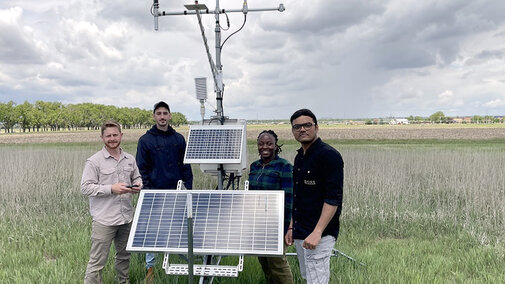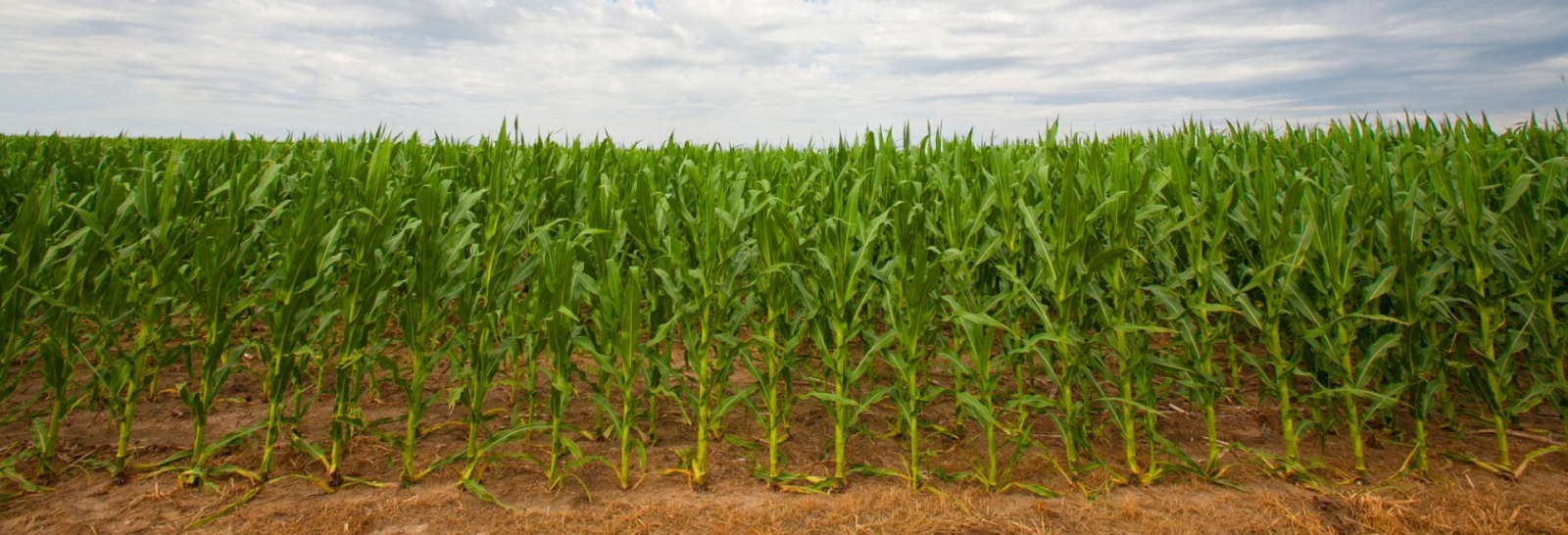Key Takeaways
Crop ET predicts crop water use by combining soil evaporation and plant transpiration.
Plant transpiration is driven by photosynthesis — as CO2 enters the leaf, water is lost through the stomata.
Crop ET can be used for irrigation scheduling to balance soil water storage while estimating available or depleted soil water.
Accurate crop ET data from trusted sources can optimize irrigation
Introduction
Irrigators are increasingly adopting data-driven technologies to optimize water applications and increase water use efficiency while maximizing yields and returns on investments. Therefore, irrigation scheduling tools that are easy to use, reliable and provide real-time crop water data are preferred. The traditional “Checkbook Irrigation Scheduling method” utilizes crop ET to estimate depleted soil water in the rootzone, helping producers know when and how much water should be applied.
Having accurate crop ET simplifies the irrigation decision-making process, such as when to start irrigation systems and at what speeds to achieve the desired application rates. However, there is still confusion about how crop ET can be effectively used to inform water application decisions for major crops grown in western Nebraska, like corn and soybean.
Crop ET can be estimated or directly measured prior to its use for irrigation scheduling. Examples of potential technology and sources able to provide reliable and accurate crop ET in Nebraska include Mesonet stations and Open Weather websites, and decision support platforms — such as Arable and Crop X’s ET sensor.
Crop ET Means Crop Water Use
Crop ET (EvapoTranspiration) can be defined in two ways – total amount of water lost from the soil and plants to the atmosphere, OR the amount of water either required or used by the plants. Therefore, crop ET also means crop water use. Quantifying water lost from the fields to the atmosphere can be used as a yardstick in determining the amount of water that needs to be added back into the soil via irrigation. That is why irrigation is very important in supplementing crop water requirements (in this context, crop ET) mainly in regions with high ET rates like semi-arid or arid regions, where high temperatures and limited rainfall occur. For this article, crop ET and crop water use will be used interchangeably.
Crop ET is the Combination of Evaporation and Transpiration Processes
As shown in in Figure 2A, the term evaporation is the amount of water lost from the soil to atmosphere in the form of water vapor; whereas transpiration is water lost from the plant through the leaves to the atmosphere as water vapor. Wind helps to transport the water vapor from the soil and leaf surfaces to the atmosphere (Figure 2B).
Each of these processes can be dominant based upon the growth stage of the crop, in addition to how irrigation is managed. Evaporation is much greater than transpiration at partial leaf canopy closure and vice versa is also true.
For example, when a typical field is well irrigated and the sun hits both leaf and soil surface as shown in Figure 2B, soil and leaf temperatures increase. This contributes to generation of heat energy, which converts water into water vapor. Later, this water vapor is transported to the atmosphere by blowing winds.
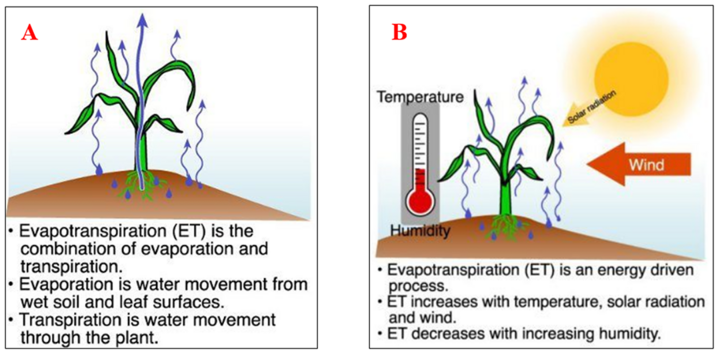
Crop ET Fundamentals: Photosynthesis Activity in the Crop is the Driver for Transpiration
Photosynthesis is one of the major processes that occurs before corn ears or soybean pods develop, in addition to pollination and fertilization. The focus of this article will be photosynthesis, since it is the main driver for transpiration.
Photosynthesis is the process that allows the manufacturing of sugars (i.e., glucose) using both water and carbon dioxide (CO2) under enough sunlight trapped by chloroplasts — leaf cells that forms chlorophyll content, or greenness in the leaf.
In other words, it is the process in which plants convert sunlight into chemical energy. This energy is derived from the created sugars, which are used by the plant during development of kernels and pods after pollination or fertilization. Thus, most of the photosynthetic activities occur in chloroplasts.
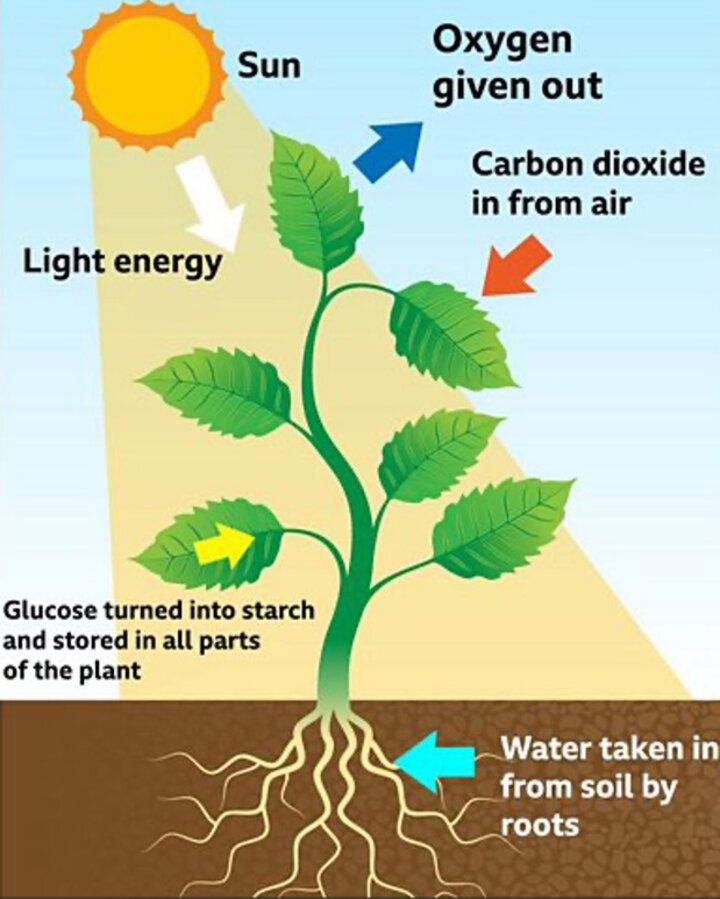
As illustrated in Figure 3, as the plant undergoes photosynthesis during a good sunlight day, more CO2 is required, which is pulled from the atmosphere through the leaf surfaces. However, as stomata — tiny pores on the leaves — open to allow more CO2, more water is lost through the same pores. Upon water molecules reaching the leaf’s surface, they are converted into water vapor by heat energy from high temperatures on the leaf canopy. This vapor is transported into the atmosphere by wind.
Crop ET is Also Driven by Available Soil Water and Climate
High transpiration rates happen under adequate soil water when the soil saturation is at least at field capacity (FC) or within the safe zone, where depleted soil water is between FC and maximum allowable depletion (MAD), depending on the managed soil type. These terms and soil-water-crop relationships are explained in the CropWatch article “Soil-Water-Plant Interaction Basics”.
Furthermore, in regions with drier climates, high vapor pressure deficit — caused by hot temperatures and low relative humidity — increases the atmosphere’s demand for water, which is reflected in higher evaporative demand or reference evapotranspiration, also known as reference/potential ET. Transpiration increases due to a greater pull of water from the plants, which causes high water potential between leaves, steam and roots, resulting in more root water extraction.
Crop ET Varies in a Growing Season
Crop ET in the growing season is mainly influenced by climate; however, it is also crucial to know the growth stages of the crop. From Figure 4, crop ET (in green line and dots) was never constant and varied with changes in the climatic conditions, including air temperature (blue line) and wind speed (blue bar graph). Peak crop ET rates were registered at highest temperatures and wind speeds.
Typically, a day with high sunshine and temperatures and extreme winds in Nebraska is when highest crop ET rates are seen. The temperatures should not exceed the maximum threshold to prevent heat stress, otherwise the plants may close their stomata as a defense mechanism against water loss, in which case less crop ET is observed.
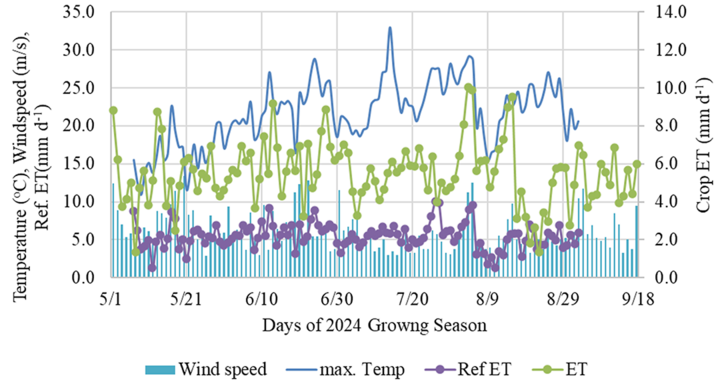
How Can ET Be Directly Measured?
Although equipment for direct measurement of crop ET such as Eddy Covariance (EC) System (Figure 5) and lysimeter (Figure 6) are expensive, they are still more essential in irrigated agricultural lands. These tools are particularly important for large projects, where EC towers are commonly used to determine regional soil water budgets and understand crop water use across crops in large watersheds. EC is more popular than lysimeters because it can quantify water over a larger scale as it measures water vapor leaving the plant and later converted into daily actual crop ET values.
Some examples of these projects include AmeriFlux— the largest crop ET monitoring platform, with a network of sites collecting data from agricultural fields across the U.S. Nebraska is one of the states with monitoring sites, which are located in Mead and maintained by research scientists at the University of Nebraska-Lincoln. These sites include irrigated continuous maize (US-Ne 1) and rainfed maize-soybean rotation (US-Ne 3), as well as Nebraska Sandhills Dry Valley (US-SdH).
Another project is a Daughtery Water for Food Project on Eddy Covariance-based ET measurements called Parallel 41 Flux Network, which is focused on providing farmers with valuable crop ET data to support informed, data-driven decisions and improve irrigation applications in the grown crops across Nebraska and neighboring states.
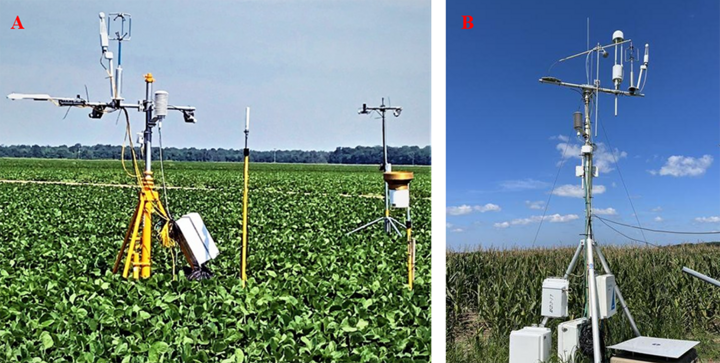
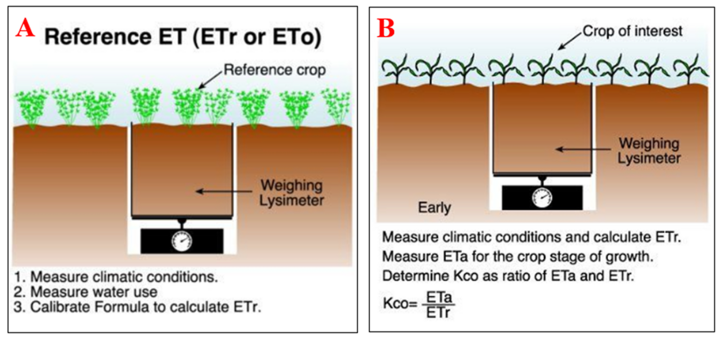
How Can ET Be Estimated?
Estimating crop ET requires understanding the relationship with reference ET (ETref). ETref is always higher than crop ET (Figure 7), since it is collected from a well-watered reference crop (either tall crop like alfalfa, commonly abbreviated as ETr, or short crop like grass grass) without any water stress. Similarly, crop ET of a fully irrigated crop can be estimated from this ETref by using an adjustment factor called crop coefficient (Kc), which varies based on the crop’s growth stage.
For both, the peak crop ET happens at the full canopy closure when the maximum Leaf Area Index (LAI) is reached at full canopy cover and when Kc is equal to 1, where both have same calculated value. As demonstrated in Figure 6B, Kc is calculated as the ratio of crop ET and ETref (i.e., Kc = crop ET/ETref) and automatically crop ET becomes the product of crop coefficient and ETref (i.e., crop ET = Kc x ETref).
These steps are explained in the NebGuides for the checkbook method and evapotranspiration basics and estimation of crop ET.
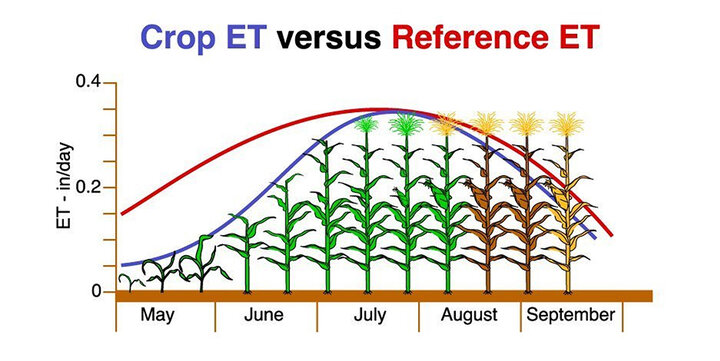
Calculating Crop ET Based on Reference ET and Crop Coefficients
The traditional way of estimating ET as explained in NebGuide on evapotranspiration basics and estimation of crop ET involves the following steps:
- Step 1: Calculate the reference ET (ETref, ETr).
- Step 2: Obtain the crop coefficient (Kc), matching with the identified growth stage in the field for the irrigated crop.
- Step 3: The final step where crop ET is calculated as the product of Kc and ETr
Step 1: Calculating Reference ET (ETref)
To simplify this step, it starts with knowing what reference ET is — it is defined as the potential ET that can be achieved by the well-watered crop, which is fully irrigated and has adequate soil moisture without any signs of water stress. Most considered crop is the tall alfalfa crop (ETr), which was also used in Figure 4.
The most trusted way of estimating ETr is by using the standard scientific and mathematical equation known as Penman monteith. The main data inputs are weather variables, including minimum and maximum temperatures, minimum and maximum relative humidity, net solar radiation and wind speed. Therefore, it is very important to have a weather station near the irrigated fields.
Conversely, the same parameter can be estimated using an atmometer gauge (often referred to as ETgage), which uses wet green cloth as an artificial surface, mimicking the natural surface of the fully irrigated alfalfa crop from which daily ETref values are estimated. Either manual or automated gauge can be used; however, automated gauge is preferred as the data is constantly logged and then accessed remotely, unlike a manual gauge where one has to manually take the readings while in the field.
Step 2: Finding Crop Coefficients (Kc Values) by Growth Stages
Crop coefficient can be defined as a dimensionless factor used to calculate crop water need amounts by adjusting reference ET to actual crop ET. Finding the Kc values starts with knowing the exact growth stage of the crop, which are used to extract the Kc value from the curves in Figure 8. Interestingly, the Kc curve follows the same trend or pattern as Leaf Area Index (LAI) but also correlates strongly with canopy cover.

Step 3: Calculate Crop ET
In the final step, crop ET is calculated from reference ET and crop coefficients, which can be found in tables for different crops on CropWatch’s GDD and ET page. CropWatch also provides tables on estimated crop water use for corn and soybean, as well as other crops.
Various Sources Where Farmers Can Access ET Data
Since crop ET is key in irrigation decision-making process — particularly if there is no installed equipment in the field to monitor crop water status — it is important to know which sources can provide accurate and reliable crop ET estimates. There are different sources that could be utilized, including:
- UNL CropWatch (under Growing Degree Days and Evapotranspiration Data), where crop ET is estimated based on the weather information collected from different Mesonet sites across the state. The user must specify the nearby weather station being used (sometimes it might be a bit far from the irrigated field) as well as crop grown and its emergence date.
- UNL Panhandle Irrigation educators and specialists provide weekly crop ET for various crops grown in Panhandle area of western Nebraska.
- Some free public irrigation decision support tools and mobile apps utilize the crop ET data to provide irrigation recommendations — in particular, UNL’s PLAN-Mobile Irrigation Management App, and other web-based dashboard platforms such as CornSoyWater, which was also developed at University of Nebraska. There are also commercial products as illustrated in Figure 9, including Arable (Figure 9A) and Crop X ET 1 Sensor (Figure 9B), both of which provide crop ET to producers on their mobile phone-enabled platforms.
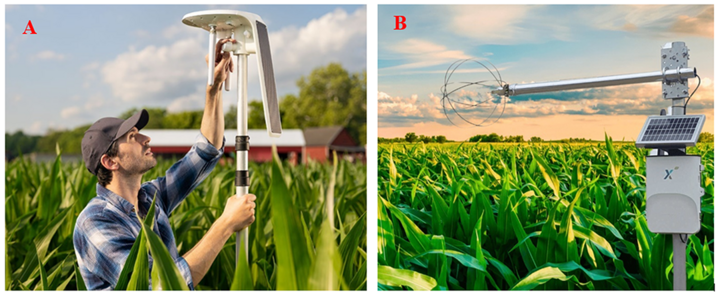
Why Should Farmers Consider Irrigating Using Crop ET?
Crop ET is an important parameter that supports efficient irrigation water management while determining the amount of water the crop has used prior — for example, in the past three to seven days — for prompt decisions on timing and amount of irrigation. Crop ET data is very reliable for farmers to use, especially when accessed from trusted sources or methods, and can improve scheduling of irrigation on farms.
The checkbook method is commonly used in Nebraska to irrigate major crops using crop ET in cases where a farmer lacks the in-field instrumentation (soil moisture sensors) to track remaining soil water. This approach is cheaper because there is no need for installing equipment if the field is near a trusted Nebraska Mesonet weather station — whether it’s owned by the farmer or not.
Furthermore, crop ET-based irrigation techniques can provide accurate irrigation recommendations if crop ET can be accessed through reliable sources, such as the High Plains Regional Climate Center and other web-based and open weather services. Different companies have developed decision support tools that automate soil water depletion calculations and always provide instant recommendations, which allow farmers to plan ahead for timely irrigation.
Lastly, peak crop ET of any crop can also be used to determine or design the system capacity against the maximum depth of water required from the irrigation system based on well capacity.
Converting Crop ET Data into Actionable Irrigation Insights
As indicated earlier, one of the best ways to translate crop ET data into irrigation decisions is by using the checkbook method, which accounts for water inputs as precipitation and irrigation, with the main output being crop ET. NebGuide EC709, “Irrigation Scheduling: Checkbook Method” has proper steps of how to establish irrigation decisions when using crop ET. Appropriate irrigation scheduling with this crop ET-based method and soil water balance model ensures that all the outputs versus inputs are balancing each other.
Irrigators are advised to first test either direct crop ET-measuring technology or crop ET-based decision support tools before purchasing — preferably through UNL Extension programs — to build confidence in using them for effective irrigation planning. These tools can be overwhelming at first, especially when learning how to apply them effectively.
There are several Nebraska Extension programs that can offer help with testing, such as UNL-Testing Ag Performance Solutions (UNL-TAPS), which allows farmers to explore these tools before adopting them on their own operations. It’s a good starting point to test irrigation strategies/technology in a risk-free environment.
Other outreach programs that engage farmers directly on their own operations — giving them the opportunity to test and evaluate advanced crop ET technologies firsthand — include:
- Mobile Irrigation Testing Lab (MITLab), which is promoting technology on farms to improve water use efficiency and irrigation management.
- Nebraska On-farm Research Network, which is working alongside farmers to explore effective irrigation strategies.
Challenges of Using Crop ET for Irrigation Decisions
- Available Mesonet weather stations across the state may be stationed far away from the managed fields, which might impact the accuracy of the computed crop ET data.
- Proper estimation of the crop ET requires constant monitoring of the crop development, with growth stages tracked at least every two days.
- Direct crop ET measurements can be very expensive and not applicable for typical growers with many center pivots and large irrigated acres that are spread out across different areas.
- Crop ET data cannot be used directly to derive decisions. Instead, it must be used to estimate soil water depletion — a process that might be difficult for some growers using a manual checkbook method and would necessitate more training.
- Automated calculations and provision of irrigation recommendations require use of decision support tools, which often entail a service fee.
- Available soil water is estimated with crop ET as input in physical model (i.e., soil water balance model), meaning there is a possibility for overestimation, which could lead to poor irrigation decisions and excessive water applications. The recommendation is to have soil moisture monitoring equipment (i.e., commercial probe or any soil moisture sensor) in one field at minimum, to doublecheck soil water estimates from the checkbook method.
- Estimating crop ET using only weather data might need require site-specific crop coefficient values to improve accuracy, since reference ET (ETref) must be adjusted to reflect actual ET.
- Farmers might need support from educators and specialists through training on utilizing crop ET for irrigation scheduling using either the checkbook technique or other existing decision support tools developed by the University, as well as commercial technology providers.
Final Remarks
The term crop ET can sometimes be confusing to farmers; however, this article can serve as a guide to understanding what it means and how it can be used for efficient irrigation management. Effective tools that can tell farmers how much and when to apply irrigation are crucial for enhancing water conservation, as well as controlling nitrate contamination to protect groundwater quality.
From Concept to Implementation:
Simply put, crop ET is the amount of water used by the crops and referred to as crop water use. It varies by growth stages and peaks at full crop growth and canopy when it reaches maximum Leaf Area Index (LAI). The cheapest approach to determine crop ET is by calculating it as the product of crop coefficients (Kc) and reference ET (ETref). Crop coefficients can vary by growth stage, and peak values occur at maximum LAI for all crops, including corn and soybean.
Conversely, crop ET can also be measured directly using sophisticated technology that is cost-prohibitive, such as Eddy Covariance Systems and lysimeters. However, cost-effective technology continues to flood the digital ag market, which more easily enables farmers to quantify crop water use in their fields — among these include Arable and CropX’s ET sensors.
The use of crop ET for irrigation scheduling can be a bit cumbersome when the common checkbook method is used, but designed platforms such as mobile apps and web-based dashboards can automate the crop ET calculations and depleted soil water estimates in the background for quick irrigation recommendations.
